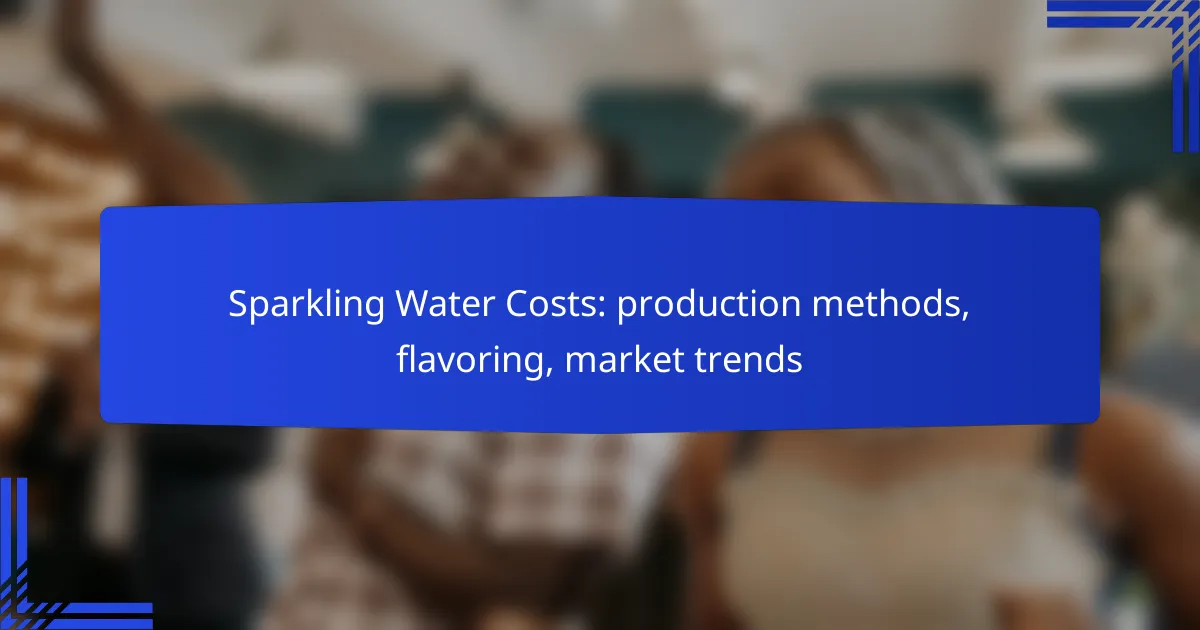Sparkling water production in Australia employs various methods to carbonate water, often using natural spring sources to enhance quality and mineral content. Flavoring options range from natural fruit extracts to artificial agents, catering to diverse regional preferences. Pricing varies widely among brands, reflecting production techniques and flavor choices, with costs typically ranging from a few Australian dollars to over ten for premium selections.
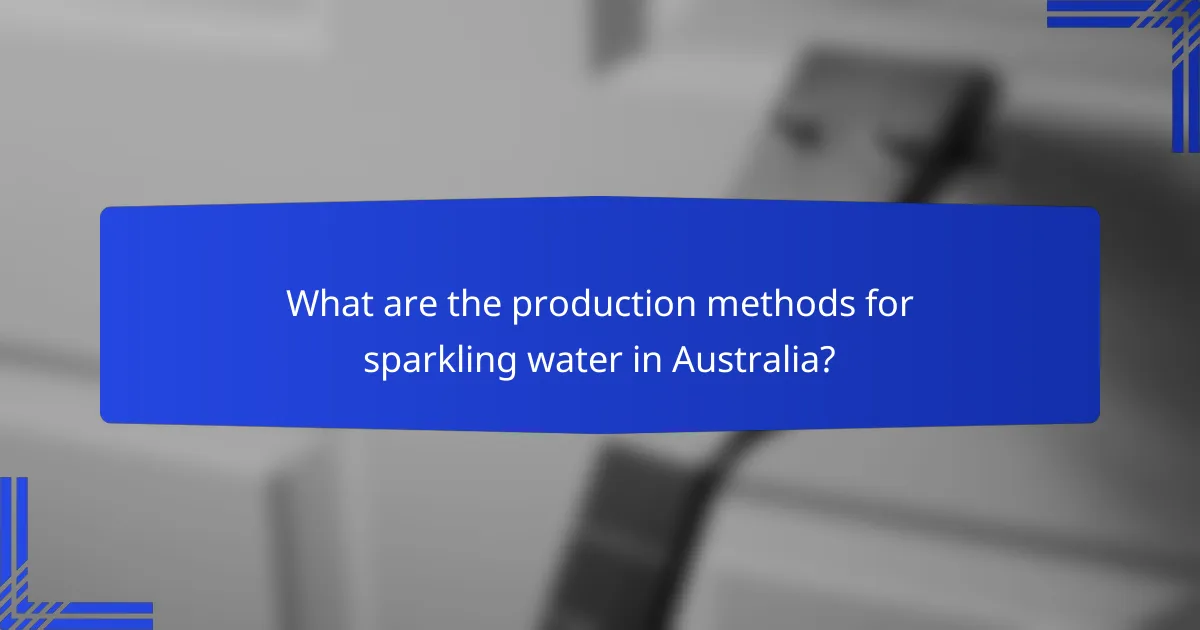
What are the production methods for sparkling water in Australia?
In Australia, sparkling water production involves various methods to infuse water with carbon dioxide, often utilizing natural spring sources. The process emphasizes quality, mineral content, and effective packaging to ensure freshness and taste.
Carbonation techniques
Carbonation techniques primarily include natural carbonation and forced carbonation. Natural carbonation occurs when water is sourced from mineral springs that contain dissolved carbon dioxide, while forced carbonation involves injecting CO2 into still water under pressure. Each method affects the taste and mouthfeel of the final product.
Producers often choose forced carbonation for greater control over carbonation levels, which can range from lightly sparkling to highly effervescent. However, natural carbonation is valued for its unique flavor profile derived from the source water.
Natural spring water sources
Natural spring water sources are crucial for producing high-quality sparkling water. In Australia, springs are often located in protected areas, ensuring the water is free from contaminants. The mineral composition of these springs varies, influencing the flavor and health benefits of the water.
Brands may highlight specific spring sources to attract consumers, emphasizing purity and unique mineral content. It’s essential for producers to comply with local regulations regarding water sourcing to maintain quality and sustainability.
Mineral content variations
The mineral content in sparkling water can significantly impact taste and health benefits. Common minerals found in spring water include calcium, magnesium, and bicarbonates, which contribute to flavor and mouthfeel. Different brands may market their products based on specific mineral profiles.
Consumers often prefer waters with balanced mineral content, as they can enhance hydration and provide essential nutrients. Understanding the mineral variations can help consumers choose products that align with their taste preferences and health goals.
Filtration processes
Filtration processes are essential to ensure the purity and safety of sparkling water. Common methods include reverse osmosis, activated carbon filtration, and UV treatment. These techniques remove impurities while preserving beneficial minerals.
Producers must select filtration methods that align with their brand values and target market. For instance, some brands may opt for minimal filtration to retain natural minerals, while others prioritize thorough purification to meet strict safety standards.
Packaging technologies
Packaging technologies play a vital role in preserving the quality of sparkling water. Common options include glass bottles, aluminum cans, and PET bottles, each offering different benefits in terms of sustainability and consumer preference. Glass is often favored for premium products, while cans are popular for their portability.
Effective packaging must also prevent CO2 loss, ensuring the product remains fizzy until consumption. Innovations in packaging materials and designs continue to evolve, focusing on reducing environmental impact while maintaining product integrity.

What are the flavoring options for sparkling water?
Sparkling water can be flavored using various methods, each offering distinct taste profiles. The most common options include natural fruit extracts, artificial flavoring agents, and herbal infusions, with regional preferences influencing choices as well.
Natural fruit extracts
Natural fruit extracts are derived from real fruits, providing authentic flavors without synthetic additives. Common options include lemon, lime, berry, and tropical fruit extracts, which can enhance the refreshing quality of sparkling water.
When choosing sparkling water with natural fruit extracts, look for products that specify the percentage of fruit content. This can vary widely, with some brands using only a small amount, while others may offer a more robust flavor experience.
Artificial flavoring agents
Artificial flavoring agents are synthetic compounds designed to mimic the taste of fruits and other flavors. These can be more cost-effective for manufacturers and allow for a wider range of flavors, such as exotic fruits or unique combinations.
While artificial flavors can provide a consistent taste, some consumers prefer to avoid them due to health concerns. Always check ingredient labels to make informed choices about the flavoring agents used in your sparkling water.
Herbal infusions
Herbal infusions involve adding herbs and botanicals to sparkling water, creating unique and refreshing flavors. Common herbs used include mint, basil, and rosemary, which can add complexity and depth to the beverage.
Herbal-infused sparkling waters are often marketed as health-conscious options, appealing to those seeking alternatives to sugary drinks. Experimenting with different herbal combinations can lead to delightful homemade versions as well.
Regional flavor preferences
Regional flavor preferences significantly influence the types of sparkling water available in different markets. For instance, citrus flavors are popular in Mediterranean countries, while berry flavors may be favored in Northern Europe.
Understanding these preferences can enhance your sparkling water experience. If traveling or shopping internationally, consider trying local brands that showcase regional flavors to discover new favorites.
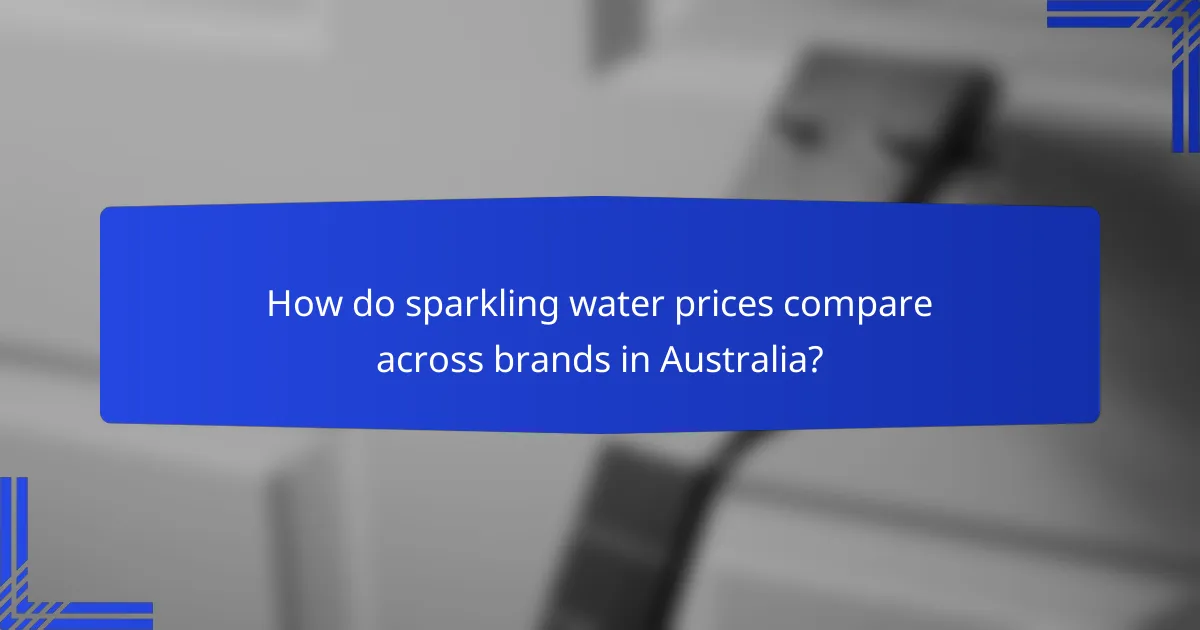
How do sparkling water prices compare across brands in Australia?
In Australia, sparkling water prices vary significantly among brands, influenced by factors like production methods and flavoring. Generally, consumers can expect to pay anywhere from a few Australian dollars to over ten dollars for premium options.
Brand price ranges
Brand price ranges for sparkling water in Australia typically fall between AUD 1 to AUD 3 for budget brands and AUD 3 to AUD 10 for premium varieties. Popular brands like San Pellegrino and Perrier often command higher prices due to their established reputations and imported status.
Local brands, such as Mount Franklin and Sparkling Spring, offer competitive pricing, usually in the lower range, appealing to cost-conscious consumers. Seasonal promotions and bulk purchase options can further influence these price ranges.
Cost per liter analysis
The cost per liter of sparkling water can vary widely, with budget brands averaging around AUD 0.50 to AUD 1.50 per liter. Premium brands, on the other hand, may range from AUD 1.50 to AUD 3.50 per liter, reflecting their higher production and import costs.
When comparing costs, consider the packaging size; larger bottles often provide better value per liter. For instance, a 1.5-liter bottle may cost less per liter than a 500ml bottle of the same brand.
Premium vs. budget options
Premium sparkling water options often feature unique flavor profiles and higher mineral content, justifying their higher price tags. Brands like San Pellegrino and Perrier are known for their distinct tastes and are often chosen for special occasions or dining experiences.
In contrast, budget options provide a more economical choice for everyday consumption, appealing to those who prioritize cost over brand prestige. Brands like Mount Franklin offer a satisfactory experience without the premium price, making them suitable for regular use.
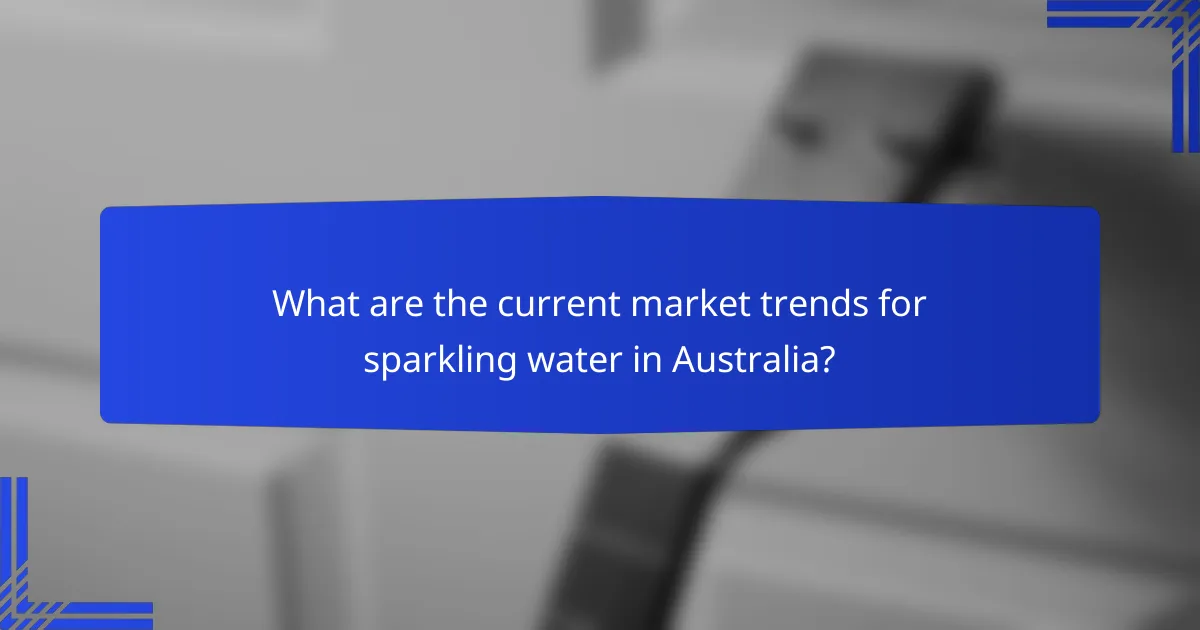
What are the current market trends for sparkling water in Australia?
The sparkling water market in Australia is experiencing significant growth, driven by changing consumer preferences towards healthier beverage options. This trend is characterized by an increasing demand for flavored sparkling waters and a focus on sustainability in production methods.
Consumer preferences
Australian consumers are increasingly opting for sparkling water as a refreshing alternative to sugary soft drinks. Flavored varieties, including fruit-infused options, are particularly popular, appealing to those seeking taste without added sugars. Brands are responding by expanding their product lines to include a range of flavors, catering to diverse palates.
Moreover, the rise of health-conscious consumers has led to a preference for products that are low in calories and free from artificial ingredients. This shift is prompting brands to highlight natural sourcing and transparent labeling to attract discerning buyers.
Health and wellness impact
Sparkling water is often marketed as a healthier choice compared to traditional soft drinks, as it typically contains no added sugars or calories. Many consumers view it as a way to stay hydrated while enjoying a fizzy texture. This perception aligns with broader health trends emphasizing hydration and wellness.
However, some health experts caution that flavored sparkling waters can still contain natural sugars or artificial sweeteners, which may impact overall health. Consumers are advised to read labels carefully to ensure they are making informed choices that align with their health goals.
Sustainability initiatives
Sustainability is becoming a key focus in the Australian sparkling water market, with many brands adopting eco-friendly practices. This includes using recyclable packaging and sourcing water from sustainable sources. Companies are increasingly transparent about their environmental impact, which resonates with environmentally conscious consumers.
Some brands are also engaging in initiatives to reduce their carbon footprint, such as optimizing production processes and investing in renewable energy. As sustainability becomes a priority for consumers, brands that demonstrate a commitment to environmental responsibility are likely to gain a competitive edge in the market.
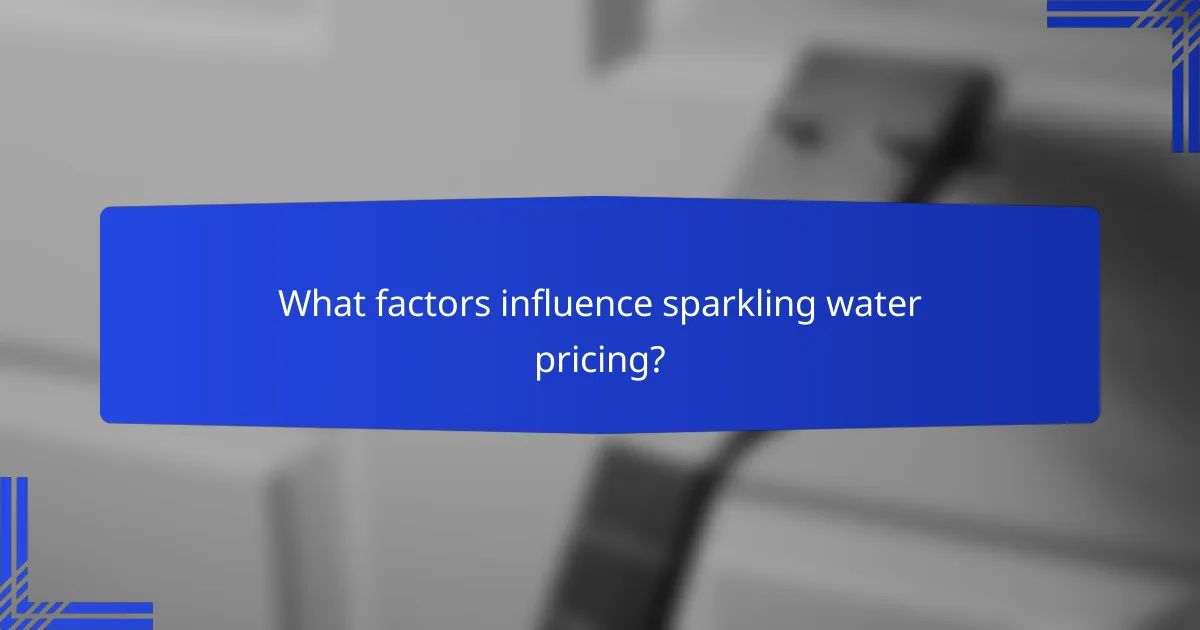
What factors influence sparkling water pricing?
Several factors influence the pricing of sparkling water, including production costs, distribution expenses, and marketing strategies. Understanding these elements can help consumers and businesses alike navigate the market more effectively.
Production costs
Production costs for sparkling water typically include sourcing raw materials, such as water and carbonation agents, as well as processing and bottling expenses. The quality of water used can significantly affect costs, with premium brands often utilizing spring or mineral water, which can be more expensive than standard tap water.
Additionally, production methods vary, with some brands opting for natural carbonation while others use artificial means. These choices can impact both the flavor profile and the overall cost of production, leading to a wide range of retail prices.
Distribution expenses
Distribution expenses encompass the costs associated with transporting sparkling water from production facilities to retailers. Factors such as distance, transportation mode, and fuel prices can significantly affect these costs. For instance, shipping sparkling water over long distances may lead to higher prices due to increased freight charges.
Moreover, local regulations and tariffs can also play a role in distribution costs, particularly for imported brands. Companies must consider these expenses when setting retail prices, which can vary widely based on geographic location.
Marketing strategies
Marketing strategies are crucial in determining the final price of sparkling water. Brands often invest heavily in advertising campaigns, packaging design, and promotional events to differentiate themselves in a crowded market. This investment can lead to higher prices, especially for brands that position themselves as premium or health-focused.
Additionally, marketing tactics such as influencer partnerships or social media promotions can drive demand, allowing brands to justify higher price points. Consumers should be aware that the perceived value created through marketing can significantly influence the cost of sparkling water products.
